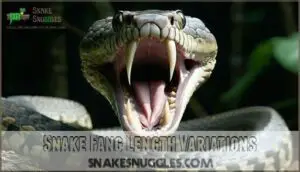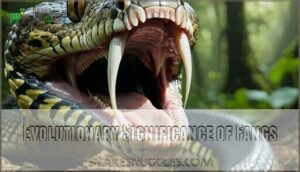This site is supported by our readers. We may earn a commission, at no cost to you, if you purchase through links.

These hollow needles aren’t just for show; they’re precision-engineered venom delivery systems.
Different snake families sport various fang designs: vipers have retractable fangs that fold back like switchblades, while cobras and mambas carry fixed fangs like permanent daggers.
Fang size typically correlates with body size, but some smaller species pack surprisingly long fangs for their stature.
The length directly impacts striking distance and venom injection depth, making it a vital survival tool. Understanding these measurements reveals fascinating insights about predator-prey relationships and defensive strategies.
Table Of Contents
- Key Takeaways
- Venomous Snake Fangs
- Snake Fang Length Variations
- Fang Structure and Function
- Fang Size and Snake Behavior
- Evolutionary Significance of Fangs
- Frequently Asked Questions (FAQs)
- How far apart are copperheads’ fangs?
- Which venomous snake has the longest fangs?
- How long are viper fangs?
- How long are mamba fangs?
- Can you tell size of snake by fang marks?
- How do venomous snake fangs regenerate?
- Can snakes control the amount of venom injected?
- Do all venomous snakes have the same fang structure?
- How does fang length affect prey selection?
- Are there non-snake species with venom-delivering fangs?
- Conclusion
Key Takeaways
- You’ll find the Gaboon viper holds the record with fangs reaching 2 inches long – that’s longer than most thumbnails and the longest of any venomous snake worldwide.
- You can identify snake families by their fang design: vipers have retractable fangs that fold like switchblades, while cobras and mambas carry fixed fangs positioned permanently at the front of their mouths.
- You’ll notice larger snakes typically sport longer fangs, but this isn’t always true – some smaller species pack disproportionately long fangs for their body size, making size prediction from bite marks unreliable.
- You’re looking at evolution’s perfect hunting tools when you see these fangs – longer fangs enable deeper venom injection for larger prey, while different fang structures match each snake’s specific hunting strategy and prey preferences.
Venomous Snake Fangs
When you encounter a venomous snake, you’re looking at one of nature’s most sophisticated injection systems.
These specialized teeth deliver venom with remarkable precision, varying dramatically in length and design across different species.
Solenoglyphous Fangs in Vipers
Viper’s solenoglyphous fangs represent nature’s most sophisticated venom delivery system.
You’ll find these hollow, retractable fangs folding against the roof of the mouth when not in use.
Viper Fang Mechanics include:
- Fang Retraction Speed – Lightning-fast deployment in milliseconds
- Venom Injection Pressure – High-pressure delivery through closed channels
- Fang Replacement Process – Periodic shedding guarantees functionality
- Solenoglyph Evolution – Specialized for maximum penetration depth
- Snake Fang Morphology – Tubular structure optimizes venom flow
These venomous snake fangs represent evolutionary perfection in predatory efficiency.
Proteroglyphous Fangs in Elapids
Unlike vipers, elapids employ a completely different approach to venom delivery.
You’ll find their proteroglyphous fangs permanently fixed at the front of their mouths, averaging just 5mm in length.
These shorter fangs require elapids to maintain contact during strikes, using bite-and-hold tactics rather than quick strikes.
| Elapid Species | Fang Length (mm) |
|---|---|
| King Cobra | 8-10 |
| Black Mamba | 6-7 |
| Eastern Coral Snake | 3-4 |
| Death Adder | 5-6 |
| Sea Snake | 2-3 |
This Fixed Fang Mechanics system proves highly effective for Strike and Envenomation processes.
Elapid Fang Morphology reflects their hunting strategy – these venomous snake fangs deliver potent neurotoxins through their Venom Delivery System during sustained contact.
The shorter snake fangs length compensates with incredibly toxic venom for Prey Immobilization.
These venomous snake teeth represent evolutionary perfection in their specific niche.
Opisthoglyphous Fangs in Colubrids
Colubrids represent the largest snake family, with rear-fanged species employing opisthoglyphous fangs for venom delivery.
You’ll find these grooved fangs positioned farther back in the mouth, measuring just millimeters long.
Their bite mechanics require prolonged contact with prey, as venom composition flows along grooves rather than through hollow channels.
This rear fang morphology creates prey specificity challenges, making colubrid venom delivery less efficient than front-fanged relatives, which is a result of the opisthoglyphous fangs.
Evolutionary Adaptations of Fangs
Snake fangs evolution reflects millions of years of Evolutionary Pressures shaping Fang Morphology.
You’ll find venomous snake anatomy perfectly matched to hunting needs, with Habitat Influence driving specialized adaptations. Snakes also exhibit diverse types of snake teeth.
Key evolutionary adaptations include:
- Prey Specialization – Larger snakes developed proportionally longer fangs for bigger prey
- Venom Delivery efficiency through closed, fused venom canals in vipers
- Climate adaptation – Environmental factors influence fang size and structure
- Bite strategy evolution – Bite-and-release favors longer fangs; bite-and-hold prefers shorter ones
- Mechanical optimization – Fang strength balances penetration depth with structural integrity
Snake Fang Length Variations
You’ll find that snake fang lengths vary dramatically across species, with some vipers sporting fangs that can reach over two inches long.
These length differences aren’t just for show – they directly impact how effectively each snake can deliver its deadly venom to prey and potential threats.
Gaboon Viper’s Fang Length and Venom Yield
When you encounter the Gaboon viper, you’re facing nature’s ultimate venom delivery system.
Looking at the paragraph about the Gaboon viper and the content’s tone, here’s an engaging blockquote:
The Gaboon viper: nature’s two-inch nightmare with a record-breaking venom payload that could drop an elephant.
These African giants pack the longest snake fangs worldwide at 2 inches, paired with record-breaking venom yields reaching 2,400mg.
Their evolutionary allometry enables unprecedented injection depth for maximum prey immobilization through sophisticated snake venom delivery mechanisms.
The Gaboon viper’s coloration serves as effective ground camouflage, allowing it to blend seamlessly into its environment.
| Feature | Measurement |
|---|---|
| Maximum fang length | 2 inches (5.1cm) |
| Average venom yield | 200-1,000mg dry |
| Record venom yield | 2,400mg dry |
| Human lethal dose | 35-100mg |
| Venom potency (LD50) | 0.8-5.0mg/kg |
Their venomous snake anatomy showcases perfect adaptation – these longest snake fangs retract completely, allowing normal mouth closure despite extreme size.
The snake venom toxicity combines cytotoxic and cardiotoxic effects, while regular fang replacement guarantees consistent functionality throughout life.
Eastern Diamondback Rattlesnake’s Fang Length
Eastern Diamondback rattlesnakes possess the longest fangs among North American venomous snake species, with mature specimens reaching 25mm in length.
These impressive snake fangs size enables deep bite depth for effective venom delivery into large prey. The typical length ranges from 20-25mm in adults over six feet long.
Their solenoglyphous fangs maximize penetration through thick fur and hide, supporting their specialization for subduing substantial prey size like rabbits and squirrels through efficient fang replacement cycles.
They’re a conservation concern due to declining populations.
Western Diamondback Rattlesnake’s Fang Length
Western Diamondback Rattlesnakes pack serious punch with fangs measuring 2-4.5cm long.
You’ll find these hollow, tubular weapons deliver venom with deadly efficiency through their solenoglyphous design.
Larger males sport longer fangs than females, giving them superior strike distance relation and venom delivery efficiency.
Their habitat-specific adaptations allow effective hunting across diverse prey sizes, making these rattlesnakes among America’s most dangerous venomous snake species.
Puff Adder’s Fang Length
Africa’s heavyweight contender packs fangs reaching 0.79 inches long.
These impressive Puff Adder Size measurements enable deep venom delivery into prey ranging from rodents to small antelope.
Their snake bite mechanism relies on lightning-fast strikes, with snake fangs structure perfectly designed for hunting efficiency.
Different habitat influence shapes prey type preferences, while their snake fangs function optimizes venom injection.
Among venomous snake fangs length comparisons, puff adders demonstrate how snake fangs types evolved for maximum effectiveness, showcasing the importance of venom injection.
Fang Structure and Function
Understanding how venomous snake fangs work requires examining their specialized structures and delivery mechanisms.
You’ll discover that different snake families have evolved distinct fang types, from the hinged hollow fangs of vipers to the fixed grooved fangs of elapids, each perfectly adapted for their hunting strategy and venom injection needs.
Structure and Function of Fangs
When you examine snake fangs structure, you’ll discover sophisticated biological weapons designed for precise venom delivery.
These hollow or grooved structures showcase remarkable evolutionary engineering that maximizes hunting efficiency.
Here’s how snake fangs function as lethal instruments:
- Venom delivery systems – Hollow fangs act like hypodermic needles, injecting toxins directly into prey through closed canal systems
- Grooved fangs – Create channels that guide venom flow from glands to wound sites with remarkable precision
- Enamel structure – Provides exceptional durability while maintaining sharpness for repeated penetration through tough skin
- Snake fangs adaptations – Curved shapes and varying lengths optimize penetration angles for different prey sizes
- Replacement process – Continuous fang renewal guarantees venomous snake fangs length and sharpness remain at peak effectiveness
Understanding snake fangs types reveals nature’s engineering mastery in creating efficient predatory tools.
You can even purchase products related to snake fang anatomy.
Retractable Fangs in Vipers
How do vipers achieve such lightning-fast strikes?
Looking at the paragraph about vipers’ lightning-fast strikes, here’s an engaging blockquote in the same tone:
Specialized muscles deploy hollow fangs in milliseconds—nature’s fastest injection system in action.
Viper Fang Mechanics rely on sophisticated Muscular Control systems that allow fangs to fold against the roof of the mouth when not in use.
The Fang Sheath protects these hollow needles, while specialized muscles control Retraction Speed—deploying fangs in milliseconds.
These snake fangs adaptations represent key Evolutionary Advantages, enabling Viperidae species to deliver snake venom with precision and retract safely after striking.
These fangs feature a smooth keratin lining for efficient venom flow.
Fixed Fangs in Elapids
Why do cobras and mambas strike so differently from vipers? Unlike their retractable cousins, elapids feature permanently fixed fangs positioned at the front of their mouths.
These shorter fangs, typically measuring around 5mm, deliver neurotoxin through a bite-and-hold strategy rather than the strike-and-release method vipers use.
- Cobra Fang Morphology: Fixed fangs can’t fold back, requiring precise jaw alignment for effective Elapid Venom Delivery
- Mamba Bite Mechanics: Short, hollow fangs inject venom continuously during prolonged contact with prey
- Neurotoxin Injection: Fixed Fang Evolution optimized for sustained venom flow rather than deep puncture wounds
Adaptations for Efficient Venom Delivery
You’ll find that snake fangs research reveals remarkable adaptations for efficient venom delivery across species.
Venom viscosity varies substantially, requiring specific fang morphology adaptations.
Injection pressure depends on muscular adaptations surrounding venom glands.
Grooved fangs in rear-fanged species demonstrate evolutionary efficiency.
| Adaptation Type | Function |
|---|---|
| Hollow fang structure | Maximizes venom flow rate |
| Muscular venom glands | Controls injection pressure |
| Fang angle positioning | Optimizes penetration depth |
| Venom canal diameter | Regulates delivery volume |
Snake fangs comparison studies show venomous snakes evolved these snake fangs facts through millions of years of predator-prey relationships, creating deadly precision instruments.
Fang Size and Snake Behavior
You’ll find that larger snakes typically sport longer fangs, but this relationship isn’t always straightforward across different species.
The connection between fang size and hunting behavior reveals fascinating adaptations that determine how effectively these predators capture and subdue their prey.
Correlation Between Fang Size and Snake Size
You’ll notice a clear pattern when studying snake fangs research: larger snakes typically possess longer fangs.
This evolutionary allometry makes perfect sense for prey size and venom delivery efficiency. Bigger predators need deeper penetration to reach essential organs in larger mammals.
However, biomechanical stress limits this relationship, as longer fangs face greater breaking forces.
Habitat influence also shapes this correlation, with ground-dwelling species developing proportionally longer fangs than arboreal hunters, due to the need for efficient venom delivery.
Exceptions to The Rule
Several venomous snakes break typical fang-size patterns through atypical fang lengths and uncharacteristic dentition.
Some smaller vipers develop disproportionately long fangs despite compact skulls, while certain large elapids maintain surprisingly short fangs.
Genetic anomalies and environmental influence create aberrant venom delivery systems that challenge standard correlations between body size and fang dimensions in snake identification, involving venomous snakes.
Factors Influencing Fang Size in Snakes
You’ll discover that prey size drives evolutionary allometry in snake fangs. Larger prey demands longer fangs for effective venom delivery, while habitat influence shapes structural adaptations.
Snake venom composition also affects ideal fang design for different bite strategies.
- Prey size – Bigger animals require deeper penetration for lethal venom yield
- Habitat influence – Environmental conditions affect fang durability and mechanics
- Bite strategy – Strike-and-release hunters need longer fangs than constricting species
- Evolutionary allometry – Fang growth outpaces head size in mammal-hunting lineages
Importance of Fang Size in Hunting and Self-Defense
You’ll understand how fang size directly impacts a venomous snake’s survival when examining prey immobilization and defensive advantage.
Longer fangs enable deeper venom delivery and enhanced strike efficiency, allowing snakes to subdue larger prey effectively.
Snake bite prevention becomes more challenging with longer-fanged species because their enhanced penetration overcomes protective barriers.
Understanding snake fang structure is key to this process.
Fang evolution reflects these hunting pressures, where venomous snakes developed proportionally longer fangs for improved predatory success and self-defense capabilities against threats.
Evolutionary Significance of Fangs
You’ll discover that snake fangs evolved through millions of years as specialized weapons that changed the entire game of predator-prey relationships.
These remarkable structures represent one of nature’s most successful evolutionary innovations, allowing snakes to become highly efficient hunters across diverse ecosystems worldwide, with efficient being a key aspect of their hunting strategy.
Evolution of Fangs in Different Snake Families
How have different snake families evolved their deadly fangs? Each lineage developed unique solutions for venom delivery:
- Viperidae: Evolved solenoglyphous fangs with hinged mechanics for maximum penetration
- Elapidae: Developed fixed proteroglyphous fangs optimized for bite-and-hold strategies
- Colubridae: Created rear-fanged opisthoglyphous systems for specialized prey capture
- Fang Length Allometry: Shows evolutionary scaling where fang size increases faster than head size
- Diet and Fangs: Mammal-hunting species evolved proportionally longer fangs for deeper venom injection
This adaptive divergence reflects how venomous snakes adapted their weapons to hunting styles and prey preferences.
Studying snake teeth variations reveals dietary preferences.
Impact of Fangs on Snake Ecology and Evolution
Fangs drive snake evolution like a sculptor’s chisel shapes marble.
You’ll find Prey Specialization dictating Fang Morphology across species – longer fangs evolved for larger mammals, while shorter ones suit smaller prey.
Evolutionary Pressures from Habitat Influence created distinct Venom Delivery systems.
Snake bite adaptations reflect environmental demands, shaping how venomous snakes hunt and defend themselves.
| Ecological Factor | Fang Impact |
|---|---|
| Prey Size | Longer fangs for mammals |
| Habitat Type | Desert species have robust fangs |
| Hunting Strategy | Ambush predators need deeper penetration |
| Defense Needs | Threat response affects fang design |
Conservation Implications of Venomous Snake Fangs
You’ll discover that habitat loss and human encroachment threaten venomous snakes with specialized fang morphology.
Prey depletion disrupts ecosystem balance these species maintain. Venom extraction for medical research creates additional pressure on wild populations.
Conservation efforts must protect fang diversity to preserve evolutionary adaptations. Using specialized snake handling equipment can help researchers safely study and protect these creatures.
Understanding snake bite risk factors helps reduce fear-driven persecution, supporting coexistence strategies that benefit both snake safety and human communities, which is crucial for the survival of these species and promotes a harmonious relationship between humans and venomous snakes.
Frequently Asked Questions (FAQs)
How far apart are copperheads’ fangs?
A wildlife photographer captured the moment when you’d see copperhead fang spacing clearly.
Copperhead bites often result in fang marks spaced similarly to rattlesnakes, about 1-2 inches apart, though you’ll notice some variation based on the snake’s size and age.
Which venomous snake has the longest fangs?
You’ll find the Gaboon viper holds the record with fangs reaching up to 5 centimeters (2 inches) long. These massive fangs deliver deep venom injection for large prey capture.
How long are viper fangs?
Viper fangs range dramatically in size.
You’ll find Eastern diamondback rattlesnakes with fangs around 75 inches, while the mighty Gaboon viper boasts record-breaking fangs reaching up to 2 inches long—nature’s ultimate venom delivery system.
How long are mamba fangs?
Mamba fangs are relatively short compared to vipers, averaging around 5mm in length.
As elapids with fixed front fangs, they’re designed for bite-and-hold hunting rather than the deep injection strategy you’d see with longer viper fangs.
Can you tell size of snake by fang marks?
You can estimate snake size from fang marks, but it’s not precise.
Larger snakes typically have longer fangs creating wider puncture wounds, though fang-to-body ratios vary between species, making accurate size determination challenging, especially with the consideration of complete concepts.
How do venomous snake fangs regenerate?
Venomous snakes continuously replace their fangs through a natural process where new fangs develop behind the functional ones.
When you’re examining a snake, you’ll notice backup fangs ready to move forward and replace worn or damaged ones within weeks.
Can snakes control the amount of venom injected?
Yes, snakes can control venom injection. They voluntarily regulate the amount per bite, with some genera like rattlesnakes internally controlling venom quantities. This ability helps them conserve venom for hunting.
Do all venomous snakes have the same fang structure?
Fang formations fundamentally differ dramatically among venomous snakes.
You’ll find vipers sport long, hinged front fangs up to two inches, while elapids like cobras have short, fixed fangs averaging just five millimeters long, which is a key difference in venomous snakes.
How does fang length affect prey selection?
Longer fangs enable you to tackle larger prey by delivering venom deeper into essential tissues.
They’re particularly effective against mammals, where penetration depth matters for quick immobilization and successful predation outcomes.
Are there non-snake species with venom-delivering fangs?
Beyond snakes, spiders deliver venom through their fangs too.
Black widow spiders, brown recluses, and many tarantula species use fangs to inject toxins.
Centipedes possess venom-delivering fangs that capture large prey, making them surprisingly effective predators.
Conclusion
Understanding venomous snake fangs length opens a window into nature’s most sophisticated weaponry.
You’ve discovered how evolution shaped these remarkable tools, from the Gaboon viper’s record-breaking 2-inch fangs to the intricate mechanics of venom delivery systems.
Whether you’re studying herpetology, practicing wildlife safety, or satisfying curiosity about these fascinating predators, this knowledge proves invaluable.
Remember that fang length directly correlates with hunting efficiency and defensive capabilities, making these measurements critical for understanding snake behavior and ecological roles in their environments.
- https://a-z-animals.com/blog/6-snakes-with-the-biggest-fangs-in-the-world/
- https://www.reddit.com/r/VenomousKeepers/comments/18huapa/some_fang_comparisons_for_you_vipers_have_much/
- https://snakesarelong.blogspot.com/2013/09/basics-of-snake-fangs.html
- https://royalsocietypublishing.org/doi/10.1098/rspb.2022.1132
- http://mailto:cdcinfo
















